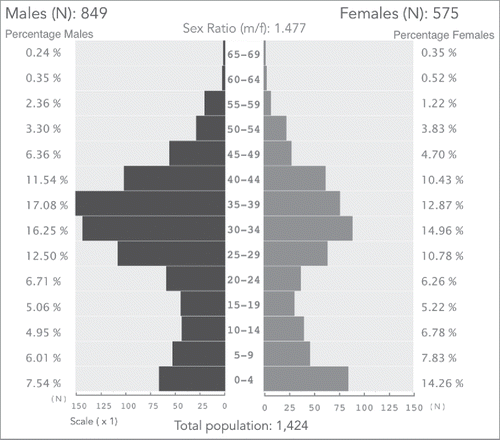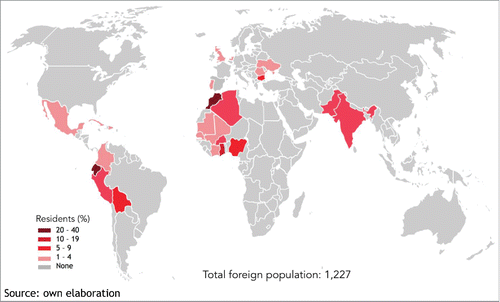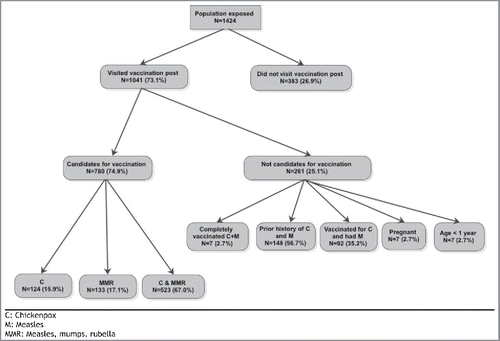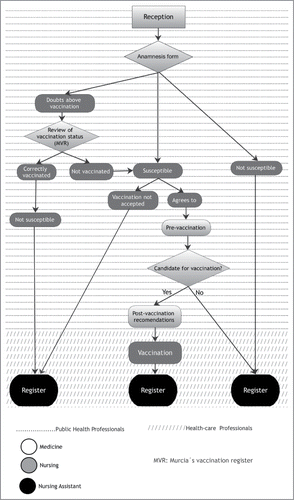ABSTRACT
Outbreaks in temporary camps are an important risk for the health of the displaced population. The town of Lorca (Murcia, Spain) suffered 2 earthquakes on May 2011 that required the re-housing of 1,424 victims in a temporary camp. Following 4 cases of chickenpox control measures were adopted among the displaced population. These measures included vaccination against chickenpox; due to the existence of cases of measles in adjacent regions, it was decided to offer measles, mumps and rubella (MMR) vaccination as well.
The immunization campaign was performed during 2 d (3 to 4 d after the first case). The immunity status of 1,041 (73,1%) of the residents was reviewed. Being vaccinated 523 (67%) against chickenpox and MMR, 133 (17%) against only MMR and 124 (16%) against only chickenpox. We consider the action taken was a success, as only 4 additional cases of chickenpox were subsequently recorded in the campsite, being avoidable only one of them.
There is a major risk of outbreaks in a disaster situation. Because of this, conducting preventive actions are indicated to avoid doing worse this critical.
Introduction
Outbreaks in temporary camps are a challenge for public health; temporary camps can be established for different reasons (migration, refugees, earthquakes, other natural disasters) but basically share the same characteristics: inadequate access to medical care, crowded living conditions and sharing common facilities.Citation1,2 Lorca, a Spanish town in the Region of Murcia with a population of 91,906 inhabitants,Citation3 suffered 2 earthquakes on May 2011, which forced that part of the population had to be evacuated ().
Those people who did not have alternative accommodation were housed in temporary camps installed from May 12th. On May 15th and 16th, 4 cases of chickenpox were recorded among children resident in the camp. Chickenpox is a highly transmissible disease,Citation4 therefore a large number of cases were expected among the susceptible population in a camp site where people were sharing common facilities. In Spain, no systematic containment actions are contemplated for potential outbreaks of the diseaseCitation5; however, on this occasion we considered the use of the chickenpox vaccine as a control measure strategy since the specific immunoglobulinCitation6 is not available in our country.
The aim of the present paper is to describe the demographic characteristics of the population in the campsite, the outbreak control measures, the results obtained, the vaccination coverage and the cost of the action.
Results
There were 1,424 refugees in the camp. Regarding to their demographic characteristics shown in the , the population consists primarily of men, 849 (59.6%) and 1,227 (86.2%) were immigrants from 25 different nationalities (), which were classified according to their region of origin (); the 2 communities most represented were North Africans and Latin Americans with 582 (40.9%) and 347 (24.4%) individuals, respectively. Most of the Spaniards present in the camp were the children of immigrants, as shown by the difference in the median age of 10.3 (IQR:4.8–32.9) years for Spaniards and 31.4 (IQR:17.2–39.0) for the population of the camp as a whole.
Table 1. Distribution of the camp population by region of origin and age.
A total of 1,041 (73.1%) residents passed through the vaccination site, with a total of 780 (74.9%) being vaccinated, 523 (67.0%) against MMR and chickenpox, 133 (17.1%) against MMR and 124 (15.9%) against chickenpox (). We found that 93.6% were previously registered on the PERSAN health database, a percentage that reached 100% in those under 12 months (). Vaccination against chickenpox and MMR was finally extended to include people over the age of 40 and 70.1% of them received at least one vaccine.
Table 2. Coverage of vaccinationFootnote* and inclusion on the PERSAN population database by age groups in the population visiting the vaccination site.
During the intervention, a fifth case of chickenpox occurred in a 5-year-old girl. After the intervention, only 4 cases of chickenpox were reported: the first was on May 29th in a 5-year-old girl who had been administered a dose of vaccine on May 18th; the second on May 31st in a young man aged 26 from Morocco who had been vaccinated with the MMR vaccine after declaring that he had suffered chickenpox previously. The other 2 cases on June 1st and 5th were in people who had joined the camp after May 20th. None of the cases presented any complications. More than 42 d later, no new cases had been detected among the population vaccinated at the camp. No serious adverse reactions were recorded.
Concerning the cost of the action, it was 30,557 euros in terms of vaccines(), while the personnel cost was 7,543 euros, including the daily gross wage of 4 nurses and 4 nursing assistants, 3 public health nurses and 2 public health doctors working during 4 working sessions. The total cost, including vaccines and personnel, was 38,100 euros.
Table 3. Distribution of the cost of the vaccines by age groups in the vaccination campaign.
Discussion
The appearance of chickenpox outbreaks in temporary and refugee camps is not unexpected,Citation1,7-11 but the situation after an earthquake in a developed country is uncommon.
The action performed at the camp can be considered successful, since the immune status of 73% of the camp's inhabitants was verified and, despite insisting on the vaccination was voluntary, 75% of them received at least one vaccine. This shows that the level of acceptance can be described as excellent. Besides that, it is noteworthy that 70% of those over 40 y of age, not being part of the target population, but being sure they had not previously been vaccinated and having not suffered the illnesses, were vaccinated even though the vaccination was not necessary.
Our action showed great effectiveness in the prevention of secondary cases as only 2 were recorded and only one of these had received the vaccine against chickenpox. The other 2 cases entered the camp after the isolation of the index cases, indicating that the disease was transmitted outside the camp. Starting the vaccination in less than 3 d after the appearance of symptoms in the first case and concluding it in less than 5 d can have influenced on the high effectiveness of the action. There were no problems with respect to safety as no consultations were received due to possible side effects and no post-vaccination rash was detected.
This action allowed us to verify that 94% of residents were included on the PERSAN health database, which proves the equity of the public health programmes in our Region, which reach a majority even of the most disadvantaged population. The reasons for the absence of the remaining 6% on PERSAN require further investigation.
Despite considering this action to be successful, we had considered, before carrying out, whether to conduct a widespread action in the entire population less than 40 y of age or to limit it to certain groups depending on their age or their original country. However, the special circumstances occurring in the camp led us to carry out the wide-ranging action on all those under 40 y of age (and even on the population over 40). First, the greater possibility of transmission (overcrowding, impossibility of limiting contacts, etc.) and second the possible appearance of severe casesCitation12 (pregnant women, babies, a potentially susceptible adult populationCitation11 and poor hygiene conditions with respecting normal dwellings).
Although it would have been idealCitation13 to have imposed vaccination systematic before admission to the camp to prevent an outbreak of chickenpox, the circumstances did not permit it. Regarding to the spread of the action to adults, consideration was given to the fact that a large part of the population came from Latin America, where the first contact with chickenpox is usually at a later age than in our country,Citation14,15 which implies a greater risk of suffering the illness in adulthood.
Limitations
Firstly, the diagnosis was not made using serological test, but the Spanish surveillance protocolsCitation7 consider a chickenpox confirmed case the existence of 2 with a clinical definition of epidemiologically related cases. So, considering that at the moment of onset of the illness there was an outbreak of chickenpox in Lorca (with a total of 163 cases in the preceding 8 weeks), we were able to take the cases as confirmed.
Regarding the absence of prior serology, in children and adolescents (less than 14 years) with a previous history of chickenpox is expected to be reliableCitation16; this, together with the possibility of an on-line consultation of the Murcia´s vaccination register (MVR), allows us to believe that the classification of susceptibility was no different to what would have been done habitually at any Health Center in our Region. This could be different for the refugees over 14 y of age (in whom anamnesis may have a high positive predictive value and a low negative predictive valueCitation17). The possible miss-classification of individuals could have occurred more frequently in the sense of vaccinating people who were already immune, rather than the other way round; however, since the post-vaccination adverse effects do not increase with the immunization of previously immune subjects,Citation18 we believe that the action chosen was preferable in our situation. In addition, we consider that the cost of the action (38,100 euros) can be borne in a situation of this kind.
A second limitation might be the possibility of over-estimating the effectiveness of the measure, due to the possible existence of a larger number of secondary cases with milder clinical signs thanks to vaccination during the days following contact; however, the cases we were really interested in avoiding were those with clinical manifestations and/or complications, and this goal was fully achieved.
Lessons learnt
On the one hand, we can remark that despite the need for prior planning of the action, it is a good idea to be flexible enough to adapt the plan to be suited to the circumstances. It became necessary to change the screening and vaccination circuit to do it easier. The public health personnel, most accustomed to the use of vaccines, was able to do all the screening faster and correctly. The definitive circuit was similar to that described by the WHO for vaccination in catastrophe situations except that we register the individuals at the end of the process whereas the WHO makes it at the beginning.Citation19 We also think that in this kind of action it is necessary to count on more professionals than initially estimated due to the wide variation in demand, making it impossible to arrange previous appointments at the vaccination site. Finally, we had to amend the anamnesis form to make it more understandable to the entire population.
On the other hand, as the WHO proposes,Citation19 both professionals and refugees have to know the goals of the campaign, who needs to be vaccinated and why, and also that all of the personnel have to be trained regarding the goal of the vaccination, the characteristics of the vaccine, crowd control and administration of vaccines. In our experience, the use of sufficiently trained public health professionals turned out to be very useful.
The third lesson learnt is that, as in previously published studies,Citation20,21 the availability of good professionals in intercultural mediation (especially with North-African population) became to be key not only due to linguistic requirements, but also because of the greater trust in these mediators than in the medical personnel. Albeit not systematically evaluated, a certain resistance to vaccination was seen in the North-African population, a resistance that was perfectly overcome thanks to the work of the mediator. No resistance to vaccination was observed in the rest of the immigrant population (Latin Americans and sub-Saharans).
And finally, we think that even in situations of catastrophe, we must try to act with the largest number of resources available: the use of the MVR for on-line consultation allowed us to access the population's vaccination records, thus contributing to a better use of resources.
Conclusions
We believe that, in a situation of natural disaster in which cases of chickenpox are detected or when there is an increased risk of measles emerging, a preventive intervention would be indicated for the entire population, in order not to worsen the critical situation of the displaced individuals. This kind of action may have a second beneficial effect, namely an increase in the herd immunity against diseases that are included in the elimination plans such as measles and rubella.
Material and methods
A cross-sectional study was conducted after the notification of 4 cases of chickenpox in children under 12 y of age among the residents of the camp to Epidemiological Surveillance Service. The case definition used was that appears in the Spanish surveillance protocols.Citation22
Outbreak control measures
The 4 cases of chickenpox notified were isolated at the field hospital enabled at the campsite; none of them was serious. The public health and health-care authorities in the Region immediately coordinated their actions and decided to carry out an exceptional intervention to control a potential outbreak of chickenpox inside the camp. This intervention included a voluntary vaccination against chickenpox and measles of all those classified as susceptible. Also, due to the fact that 430 cases of measles had been notified in the adjacent region of Andalusia,Citation23 it was included the MMR vaccine, especially because of the need of waiting a 4 weeks interval to vaccinate against MMR if faced with a case of measles.Citation24
Due to the characteristics of the camp, all the refugees were treated as contacts of the cases, taking the onset of the exanthema in the index case as the first possible moment of exposure. Vigilance measures remained in place for 42 d (twice the incubation period) following the appearance of the last case.
Campaign organization and logistics
Preparatory meetings were held and supporting material was prepared: pre-vaccination questionnaires and information leaflets about the MMR and chickenpox vaccines in several languages. All of the personnel involved in the action received a short training course.
Four health-care teams, including a nurse and a nursing assistant, were set up. Coordination was conducted by personnel of public health (3 nurses and 2 doctors) and 2 interpreters for the French- and English-speaking populations. The field station had online connections to the MVR.Citation25
The action protocol established a target population between 12 months and 40 y old who had not suffered chickenpox and had not previously been vaccinated, as well as the susceptible health-care and other personnel.
Several ways were established to reach the target population: a) everyone present at the camp was contacted directly by visiting the tents and giving information, b) the Red Cross personnel informed all refugees at breakfast and dinner times, c) the personnel at the entrance to the camp informed refugees about the campaign, and d) on the day of vaccination, the Military Emergency Unit (UME), the body responsible for co-ordinating the campsite, made a pre-requisite to be admitted in the camp visiting the vaccination site to be informed.
It was created a circuit for vaccination purposes (), where a team of 2 public health professionals asked to the refugees about their medical history. Furthermore, vaccination status about chickenpox and/or measles were consulted on the MVR. Finally, individuals were defined as susceptible if they had not suffered the respective diseases or if having doubts about it and when they were not vaccinated. In the screening, 3 standard documents were used (): an anamnesis form, a pre-vaccination questionnaire and post-vaccination recommendations. All the actions undertaken were registered on the MVR. All people passing through the vaccination site were provided with an immunization record if they had been vaccinated or a document showing that they were not candidates for vaccination.
Figure 6. Documents used in the vaccination process: anamnesis form, pre-vaccination questionnaire and subsequent recommendations.
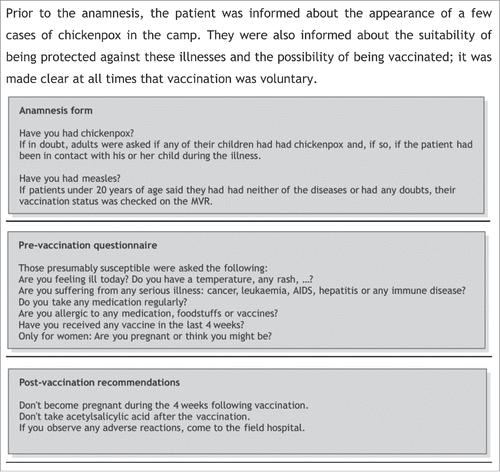
The vaccination site was operated during 2 d with a morning and afternoon schedule (May 19th-20th).
Study variables and data source
The UME provided a register with all of the inhabitants of the camp, which was completed with the data obtained from the anamnesis form and the MVR. The study variables were: date of birth (age), date of admission to the camp, nationality, gender, history of measles and chickenpox, prior vaccination against chickenpox and MMR vaccine, and whether or not they had previously been included on the PERSAN population database (a regional medical database). The age was categorized in 4 intervals: ≤ 12 months (not susceptible to receive the chickenpox vaccine), 1–12 y (chickenpox vaccine not included in the Spanish Immunization Schedule for this age), 13–40 y (chickenpox vaccine included in the Spanish Immunization Schedule for susceptible individuals) and >40 y (people not included initially in the target population of the campaign).
To calculate the cost of the intervention, we include the costs of the vaccines (applying price according to the procurement mechanism developed that year in the Murcia Region) and the wage of personnel provided by the Regional Government's Department of Health and Social Policy and the Murcian Health Service (daily gross wage of 4 nurses and 4 nursing assistants, 3 public health nurses and 2 public health doctors).
For the description of the demographic variables and vaccine coverage, the SPSS 21 and Epi-Info 3.5.3 software were used.
Disclosure of potential conflicts of interest
I also declare that none of the authors of the work have a conflict of interest in relation to it.
Acknowledgments
To thank the collaboration and all its good deeds of the State Security Forces and Corps, since without them the correct functioning of the refugee camp would not have been possible. To the intercultural mediators, who were the key players in the vaccination campaign and, all the health staff who contributed in some way to the prevention and control of the outbreak. Especially, to make mention of honor to the 9 mortal victims left behind by the earthquake.
References
- Jones G, Haeghebaert S, Merlin B, Antona D, Simon N, Elmouden M, Battist F, Janssens M, Wyndels K, Chaud P. Measles outbreak in a refugee settlement in Calais, France: January to February 2016. Euro Surveill 2016; 21(11):30167; PMID:27020578; https://doi.org/10.2807/1560-7917.ES.2016.21.11.30167
- Semenza JC, Carrillo-Santisteve P, Zeller H, Sandgren A, van der Werf M, Severi E, Pastore Celentano L, Wiltshire E, Suk JE, Dinca I, et al. Public health needs of migrants, refugees and asylum seekers in Europe, 2015: infectious disease aspects. Eur J Public Health 2016; 26(3):372-3; PMID:27053729; https://doi.org/10.1093/eurpub/ckw023
- Centro Regional de Estadística Región de Murcia. Población según lugar de nacimiento por sexo. Murcia: CREM; [accessed 2016 Sep 12]. 2012. Available from: http://econet.carm.es/web/crem/inicio/-/crem/sicrem/PU_padron/p11/sec34.html
- Schmid DS, Jumaan AO. Impact of varicella vaccine on varicella-zoster virus dynamics. Clin Microbiol Rev 2010; 23(1):202-17; PMID:20065330; https://doi.org/10.1128/CMR.00031-09
- Dirección General de Salud Pública. Consejería de Sanidad de la Región de Murcia. Vacunación frente a la varicela: implicaciones en Salud Pública. Murcia: DGSP; [accessed 2016 Sep 23]. n.d. Available from: http://murciasalud.es/recursos/ficheros/63009-vacunación.pdf
- Marin M, Güris D, Chaves S, Schmid S, Seward J. Prevention of Varicella. Recommendations of the Advisory Committee on Immunization Practices (ACIP). MMWR 2007; 56(RR-4):1-40; PMID:17585291
- Shimakawa Y, Camelique O, Arivoshi K. Outbreak of chickenpox in a refugee camp of northern Thailand. Confl Health 2010; 4:4
- Cadieux G, Redditt V, Graziano D, Rashid M. Risk factors for varicella susceptibility among refugees to Toronto, Canada. J Immigr Minor Health 2017; 19(1):6-14; PMID:26590922; https://doi.org/10.1007/s10903-015-0313-y
- Haas E, Dukhan L, Golstein L, Lyandres M, Gdalevich M. Use of vaccination in a large outbreak of primary varicella in a detention setting for African immigrants. Int Health 2014; 6(3):203-7; PMID:24682723; https://doi.org/10.1093/inthealth/ihu017
- Lesens O, Baud O, Henquell C, Lhermet Nurse A, Beytout J. Varicella outbreak in Sudanese refugees from Calais. J Travel Med 2016; 23(5); PMID:27378366; https://doi.org/10.1093/jtm/taw042
- Den Heijer CDJ, Heijman KCMT, Hoebe CJPA. Uitbraak van waterpokken in eenasielzoekerscentrum. Infectieziekten Bulletin 2015; 26(2):34-6
- Centers for Disease Control and Prevention. Strategies for the control and investigation of varicella outbreaks manual, 2008. Atlanta: CDC; [accessed 2016 Oct 17]. 2008. Available from: https://www.cdc.gov/chickenpox/outbreaks/downloads/manual.pdf
- de Valliere S, Cani N, Grossenbacher M, Puig F, Masserey E, Bodenmann P. Comparison of two strategies to prevent varicella outbreaks in housing facilities for asylum seekers. Int J Infect Dis 2011; 15(10):e716-21; PMID:21802330; https://doi.org/10.1016/j.ijid.2011.06.001
- Valerio L, Escribà JM, Fernández-Vázquez J, Roca C, Milozzi J, Solsona L, Molina I. Biogeographical origin and varicella risk in the adult immigration population in Catalonia, Spain (2004–2006). Euro Surveill 2009; 14(37):19332
- Knowles SJ, Grindy K, Cahill I, Cafferkey MT. Susceptibility to infection rash illness in pregnant women from diverse geographical regions. Commun Dis Public Health 2004; 7(4):344-8; PMID:15779804
- Diez-Domingo J, Gil A, San Martín M, González A, Esteban J, Baldó JM, Planelles MV, Ubeda MI, Graullera M, Peris A. Seroprevalence of varicella among children and adolescents in Valencia, Spain. Reliability of the parent's reported history and the medical file for identification of potential candidates for vaccination. Hum Vaccin 2005; 1(5):204-6; PMID:17012857
- Urbiztondo L, Bayas JM, Broner S, Costa J, Esteve M, Campins M, Borràs E, Dominguez A. Varicella-zoster virus immunity among health care workers in Catalonia. Vaccine 2014; 32(45):5945-8; PMID:25219564; https://doi.org/10.1016/j.vaccine.2014.08.055
- Marshall G, General Considerations. In: Marshall G. The Vaccine Handbook. A practical guide for clinicians. Philadelphia: Lippincot Williams Wilkins; 2004. p. 1-28
- World Health Organization. Communicable disease control in emergencies: A field manual. WHO/CDS/2005.27. Geneva, Switzerland: WHO; 2005.
- Garrett C, Treichel C, Ohmans P. Barriers to health care for immigrants and noimmigrants: a comparative study. Minnesota Med 1998; 81:52-55; PMID:9577539
- Nierkens V, Krumeich A, de Ridder R, van Dongen M. The future of intercultural mediation in Belgium. Patient Educ Couns 2002; 46(4):253-9; PMID:11932124
- Centro Nacional de Epidemiología. Definiciones de caso y formularios de notificación a nivel central de las enfermedades de declaración obligatoria. Madrid, Spain: Ministerio de Sanidad y Consumo; 2001.
- Mayoral Cortes J, Perez Morilla E, Gallardo Garcia V, Navarro Mari J, Perez Ruiz M, Hermosilla R, Díaz-Borrego J, Rodriguez Romero E, Ruiz Fernandez J. Measles outbreak in Andalusia, Spain, January to August 2011. Euro Surveill 2012; 17(42):20300; PMID:23098824
- Centers for Disease Control and Prevention. General Recommendations on Immunization- Recommendations of the Advisory Committee on Immunization Practices (ACIP). MMWR 2011; 60(2):1-64; PMID:21293327
- Bernal-González PJ, Navarro-Alonso JA, Pérez-Martín JJ. Computerised vaccination register for the Murcia region, Spain, 1991 to 2011. Euro Surveill 2012; 17(16):20150; PMID:22551463


